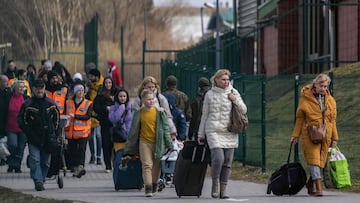Ukraine-Russia war: what are the differences between refugee, asylee and an internally displaced person?
As with all conflicts, those suffering the most are the civilians in the crossfire. Here are the definitions of some of the most vulnerable that need support.

A key feature of every conflict, be it in Africa, Europe or anywhere else, is that civilians take the brunt of the fighting. Despite rules about who is a fair target or not in war, there are no guarantees that civilians can be kept safe.
This is even more apparent when civilians themselves are expressly targeted, as has been seen throughout the war in Ukraine. As the Russian advanced slowed, and was then turned back, their tactics changed. Attacks on densely populated areas have become the norm, and as was seen in the town of Bucha, the indiscriminate killing of Ukrainian civilians has become policy of the Russian army.
Most importantly for refugees, they are always a victim, and should never be treated as a problem. United Nations Refugee Agency (UNHCR) estimates that there were 82.4 million people worldwide that been displaced from their home at the end of 2020. There is confusion around the differences between displaced persons. We’re here to clear that up.
What are the differences in definitions?
According to the 1951 UN refugee convention, a refugee is:

Someone who is unable or unwilling to return to their country of origin owing to a well-founded fear of being persecuted for reasons of race, religion, nationality, membership of a particular social group, or political opinion.
Usually, this will be a large amount of people. For context, there are more than 4 million people who have become refugees after fleeing Ukraine since the end of February 2022. Most are being housed in eastern Europe, in countries that do not have the facilities to keep some of the world’s most vulnerable safe.
An asylum seeker is someone who has already left their country and has applied for asylum in another nation. Having asylum granted is usually difficult, as the person applying for asylum has to prove that they needed to leave their country to stay alive, for example.
The key difference between refugees and asylum seekers is that asylum seekers are often in smaller groups. People and the media tend to be more aware when there is a refugee ‘crisis’ as signs are visible; a mass movement of people from somewhere to someone else. This isn’t so obvious with a much smaller amount of people.
An internally displaced person (IDP) is a refugee, but someone who has not crossed international borders. IDPs usually outnumber refugees, as for many it is simply not possible to escape a dangerous situation. For example, in Syria, the latest estimates from the UNHCR say that there are 6.2 million people displaced within the country, the largest amount of IDPs in the world. Worldwide, there are 48 million internally displaced people. This has risen from 21 million in 1990.






